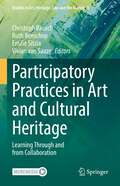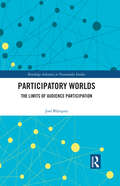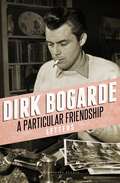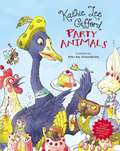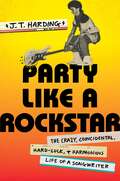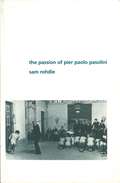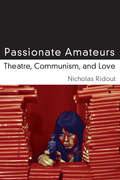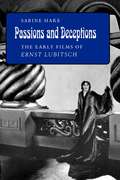- Table View
- List View
Parody, Politics and the Populace in Greek Old Comedy
by Professor Donald SellsThis book argues that Old Comedy's parodic and non-parodic engagement with tragedy, satyr play, and contemporary lyric is geared to enhancing its own status as the preeminent discourse on Athenian art, politics and society. Donald Sells locates the enduring significance of parody in the specific cultural, social and political subtexts that often frame Old Comedy's bold experiments with other genres and drive its rapid evolution in the late fifth century. Close analysis of verbal, visual and narrative strategies reveals the importance of parody and literary appropriation to the particular cultural and political agendas of specific plays.This study's broader, more flexible definition of parody as a visual – not just verbal – and multi-coded performance represents an important new step in understanding a phenomenon whose richness and diversity exceeds the primarily textual and literary terms by which it is traditionally understood.
Participatory Practices in Art and Cultural Heritage: Learning Through and from Collaboration (Studies in Art, Heritage, Law and the Market #5)
by Christoph Rausch Ruth Benschop Emilie Sitzia Vivian Van SaazeThis edited volume analyzes participatory practices in art and cultural heritage in order to determine what can be learned through and from collaboration across disciplinary borders. Following recent developments in museology, museum policies and practices have tended to prioritize community engagement over a traditional focus on collecting and preserving museal objects. At many museal institutions, a shift from a focus on objects to a focus on audiences has taken place. Artistic practices in the visual arts, music, and theater are also increasingly taking on participatory forms. The world of cultural heritage has seen an upsurge in participatory governance models favoring the expertise of local communities over that of trained professionals. While museal institutions, artists, and policy makers consider participation as a tool for implementing diversity policy, a solution to social disjunction, and a form of cultural activism, such participation has also sparked a debate on definitions, and on issues concerning the distribution of authority, power, expertise, agency, and representation. While new forms of audience and community engagement and corresponding models for “co-creation” are flourishing, fundamental but paralyzing critique abounds and the formulation of ethical frameworks and practical guidelines, not to mention theoretical reflection and critical assessment of practices, are lagging.This book offers a space for critically reflecting on participatory practices with the aim of asking and answering the question: How can we learn to better participate? To do so, it focuses on the emergence of new norms and forms of collaboration as participation, and on actual lessons learned from participatory practices. If collaboration is the interdependent formulation of problems and entails the common definition of a shared problem space, how can we best learn to collaborate across disciplinary borders and what exactly can be learned from such collaboration?
Participatory Worlds: The limits of audience participation (ISSN)
by José BlázquezThis book is an in-depth analysis of participatory worlds, practices beyond the mainstream models of content production and IP management that allow audience members to contribute canonically to the expansion of storyworlds, blurring the line between the traditional roles of consumers and producers.Shifting discussions of participatory culture and cross-media production and consumption practices to more independent media contexts, the book explores the limits, borders and boundaries of participating in today’s digital media storyworlds. The text examines how audience participation works, identifying opportunities to make it a meaningful practice for audiences and an asset for IP owners, and discussing the challenges and barriers that the application of participatory culture brings along. The book defines what meaningful participation is by introducing the concept of ‘intervention’ and explains a range of factors impacting the way in which participatory worlds and relationships between producers, audiences and the world are shaped.This volume will be of great relevance to media practitioners, scholars and students interested in transmedia storytelling, fandom, literary studies and comparative literature, new media and digital culture, gaming and media studies.
Participatory Worlds: The limits of audience participation (ISSN)
by José BlázquezThis book is an in-depth analysis of participatory worlds, practices beyond the mainstream models of content production and IP management that allow audience members to contribute canonically to the expansion of storyworlds, blurring the line between the traditional roles of consumers and producers.Shifting discussions of participatory culture and cross-media production and consumption practices to more independent media contexts, the book explores the limits, borders and boundaries of participating in today’s digital media storyworlds. The text examines how audience participation works, identifying opportunities to make it a meaningful practice for audiences and an asset for IP owners, and discussing the challenges and barriers that the application of participatory culture brings along. The book defines what meaningful participation is by introducing the concept of ‘intervention’ and explains a range of factors impacting the way in which participatory worlds and relationships between producers, audiences and the world are shaped.This volume will be of great relevance to media practitioners, scholars and students interested in transmedia storytelling, fandom, literary studies and comparative literature, new media and digital culture, gaming and media studies.
A Particular Friendship: Letters
by Dirk BogardeFirst published in 1989, A Particular Friendship follows Dirk Bogarde's first four memoirsThis epistolary collection finds Bogarde at his most honest and touching, engaging in conversation with a woman he has never met, and whose only interest in him comes from the simple fact that he now happens to live in a house that she once owned. These letters provide an insight into the wit and intelligence of a great man without the stifling constraints of other literary forms. it presents us with a platform and a relationship that allowed Bogarde to freely reminisce, discuss politics, and gossip about those around him.The correspondences were all written before Bogarde saw himself as an author and stand as a testament to his literary talent, domestic sensibilities, and his unquestionable compassion in sharing so much with a complete stranger.
Partners in suspense: Critical essays on Bernard Herrmann and Alfred Hitchcock
by K. J. Donnelly Steven RawleThis volume of spellbinding essays explores the tense relationship between Alfred Hitchcock and Bernard Herrmann, providing new perspectives on their collaboration. Featuring chapters by leading scholars of Hitchcock's work, including Richard Allen, Charles Barr, Murray Pomerance, Sidney Gottlieb and Jack Sullivan, the collection examines the working relationship between the pair and the contribution that Herrmann's work brings to Hitchcock's idiom. Examining key works, including The Man Who Knew Too Much, Psycho, Marnie and Vertigo, the essays explore approaches to sound, music, collaborative authorship and the distinctive contribution that Herrmann's work with Hitchcock brought to this body of films, examining the significance, meanings, histories and enduring legacies of one of film history's most important partnerships. By engaging with the collaborative work of Hitchcock and Herrmann, the book explores the ways in which film directors and composers collaborate, how this collaboration is experienced in the film text, and the ways in which such partnerships inspire later work.
Partners in suspense: Critical essays on Bernard Herrmann and Alfred Hitchcock
by Steven Rawle and K. J. DonnellyThis volume of spellbinding essays explores the tense relationship between Alfred Hitchcock and Bernard Herrmann, providing new perspectives on their collaboration. Featuring chapters by leading scholars of Hitchcock's work, including Richard Allen, Charles Barr, Murray Pomerance, Sidney Gottlieb and Jack Sullivan, the collection examines the working relationship between the pair and the contribution that Herrmann's work brings to Hitchcock's idiom. Examining key works, including The Man Who Knew Too Much, Psycho, Marnie and Vertigo, the essays explore approaches to sound, music, collaborative authorship and the distinctive contribution that Herrmann's work with Hitchcock brought to this body of films, examining the significance, meanings, histories and enduring legacies of one of film history's most important partnerships. By engaging with the collaborative work of Hitchcock and Herrmann, the book explores the ways in which film directors and composers collaborate, how this collaboration is experienced in the film text, and the ways in which such partnerships inspire later work.
Party Animals
by Kathie Lee GiffordSuccessful talk show host, singer, songwriter, actress, and author Kathie Lee Gifford has come up with a delightful book for children! Lucy Goosy is carefully reviewing her list of animals to invite for her birthday party. She has to make sure to invite the right guests so that her party will be perfect. But when she focuses on everyone's bad qualities, instead of good, she discovers that there is no one to attend! With a little help from the Wise Owl, Lucy Goosy discovers it is our special characteristics that make us unique. Written in adorable sing-song rhyme, Kathie Lee Gifford's new picture book for children teaches us that we are all special because we are different! This endearing book comes with a CD, where the accompanying song "Party Animals” is performed by the author so kids can read and sing along with the music.
Party Animals: A Hollywood Tale of Sex, Drugs, and Rock 'n' Roll Starring the Fabulous Allan Carr
by Robert HoflerAllan Carr was Hollywood&’s premier party-thrower during the town&’s most hedonistic era—the cocaine-addled, sexually indulgent 1970s. Hosting outrageous soirees with names like the Mick Jagger/Cycle Sluts Party and masterminding such lavishly themed opening nights as the Tommy/New York City subway premiere, it was Carr, an obese, caftan-wearing producer—the ultimate outsider—who first brought movie stars and rock stars, gays and straights, Old and New Hollywood together. From the stunning success of Grease and La Cage aux Folles to the spectacular failure of the Village People&’s Can&’t Stop the Music, as a producer Carr&’s was a rollercoaster of a career punctuated by major hits and phenomenal flops—none more disastrous than the Academy Awards show he produced featuring a tone-deaf Rob Lowe serenading Snow White, a fiasco that made Carr an outcast, and is still widely considered to be the worst Oscars ever. Tracing Carr&’s excess-laden rise and tragic fall—and sparing no one along the way—Party Animals provides a sizzling, candid, behind-the-scenes look at Hollywood&’s most infamous period.
Party Like a Rockstar: The Crazy, Coincidental, Hard-Luck, and Harmonious Life of a Songwriter
by J.T. HardingThis fun and fast-paced rock-and-roll memoir from hit singer-songwriter J.T. Harding shows what it takes to go from South Detroit to the top of the Nashville charts.In PARTY LIKE A ROCKSTAR, J.T. Harding charts his life from a kid growing up in Michigan to a chart-topping songwriter living in Nashville and working with country music stars like Keith Urban and Kenny Chesney. As a kid playing rock n' roll in his parents' garage, Harding's was a world in which every taste of new music—from KISS to Prince and everyone in between—was a revelation. Inspired by his favorite artists, Harding abandons the classic "American Dream" and runs away to Los Angeles, where he forms a band and becomes part of the music scene there, all the while selling records to his favorite artists and producers at Tower Records.A story of youth, rebellion, and determination, PARTY LIKE A ROCKSTAR is a memoir for music lovers and an invaluable how-to guide for anyone who wants to learn how to write a hit song. Fun and heartfelt, Harding's memoir is the story of one man's unshakable love for rock and roll, how it guided him through some of the greatest tragedies—and greatest triumphs—of his wild and unvarnished life.
Pasolini Requiem: Second Edition
by Barth David SchwartzPier Paolo Pasolini (1922–75) was one of the most important Italian intellectuals of the post–World War II era. An astonishing polymath—poet, novelist, literary critic, political polemicist, screenwriter, and film director—he exerted profound influence on Italian culture up to his untimely death at the age of fifty-three. This revised edition of what the New York Times Book Review has called “the standard Pasolini biography” introduces the artist to a new generation of readers. Based on extensive interviews with those who knew Pasolini, both friends and enemies, admirers and detractors, Pasolini Requiem chronicles his growth from poet in the provinces to Italy’s leading “civil poet”; his flight to Rome in 1950; the scandalous success of his two novels and political writing; and his transition to film, where he started as a contributor to the golden age of Italian cinema and ended with the shocking Salò, or the 120 Days of Sodom. Pasolini’s tragic and still unsolved murder has remained a subject of contentious debate for four decades. The enduring fascination with who committed the crime—and why—reflects his vital stature in Italy’s political and social history. Updated throughout and with a new afterword covering the efforts to reopen the investigation—and the legal maelstrom surrounding Pasolini’s demise—this edition of Pasolini Requiem is a riveting account of one of the twentieth century’s most controversial, ever-present iconoclasts.
Pasolini Requiem: Second Edition
by Barth David SchwartzPier Paolo Pasolini (1922–75) was one of the most important Italian intellectuals of the post–World War II era. An astonishing polymath—poet, novelist, literary critic, political polemicist, screenwriter, and film director—he exerted profound influence on Italian culture up to his untimely death at the age of fifty-three. This revised edition of what the New York Times Book Review has called “the standard Pasolini biography” introduces the artist to a new generation of readers. Based on extensive interviews with those who knew Pasolini, both friends and enemies, admirers and detractors, Pasolini Requiem chronicles his growth from poet in the provinces to Italy’s leading “civil poet”; his flight to Rome in 1950; the scandalous success of his two novels and political writing; and his transition to film, where he started as a contributor to the golden age of Italian cinema and ended with the shocking Salò, or the 120 Days of Sodom. Pasolini’s tragic and still unsolved murder has remained a subject of contentious debate for four decades. The enduring fascination with who committed the crime—and why—reflects his vital stature in Italy’s political and social history. Updated throughout and with a new afterword covering the efforts to reopen the investigation—and the legal maelstrom surrounding Pasolini’s demise—this edition of Pasolini Requiem is a riveting account of one of the twentieth century’s most controversial, ever-present iconoclasts.
Pasolini Requiem: Second Edition
by Barth David SchwartzPier Paolo Pasolini (1922–75) was one of the most important Italian intellectuals of the post–World War II era. An astonishing polymath—poet, novelist, literary critic, political polemicist, screenwriter, and film director—he exerted profound influence on Italian culture up to his untimely death at the age of fifty-three. This revised edition of what the New York Times Book Review has called “the standard Pasolini biography” introduces the artist to a new generation of readers. Based on extensive interviews with those who knew Pasolini, both friends and enemies, admirers and detractors, Pasolini Requiem chronicles his growth from poet in the provinces to Italy’s leading “civil poet”; his flight to Rome in 1950; the scandalous success of his two novels and political writing; and his transition to film, where he started as a contributor to the golden age of Italian cinema and ended with the shocking Salò, or the 120 Days of Sodom. Pasolini’s tragic and still unsolved murder has remained a subject of contentious debate for four decades. The enduring fascination with who committed the crime—and why—reflects his vital stature in Italy’s political and social history. Updated throughout and with a new afterword covering the efforts to reopen the investigation—and the legal maelstrom surrounding Pasolini’s demise—this edition of Pasolini Requiem is a riveting account of one of the twentieth century’s most controversial, ever-present iconoclasts.
Pasolini Requiem: Second Edition
by Barth David SchwartzPier Paolo Pasolini (1922–75) was one of the most important Italian intellectuals of the post–World War II era. An astonishing polymath—poet, novelist, literary critic, political polemicist, screenwriter, and film director—he exerted profound influence on Italian culture up to his untimely death at the age of fifty-three. This revised edition of what the New York Times Book Review has called “the standard Pasolini biography” introduces the artist to a new generation of readers. Based on extensive interviews with those who knew Pasolini, both friends and enemies, admirers and detractors, Pasolini Requiem chronicles his growth from poet in the provinces to Italy’s leading “civil poet”; his flight to Rome in 1950; the scandalous success of his two novels and political writing; and his transition to film, where he started as a contributor to the golden age of Italian cinema and ended with the shocking Salò, or the 120 Days of Sodom. Pasolini’s tragic and still unsolved murder has remained a subject of contentious debate for four decades. The enduring fascination with who committed the crime—and why—reflects his vital stature in Italy’s political and social history. Updated throughout and with a new afterword covering the efforts to reopen the investigation—and the legal maelstrom surrounding Pasolini’s demise—this edition of Pasolini Requiem is a riveting account of one of the twentieth century’s most controversial, ever-present iconoclasts.
The Passion of Pier Paolo Pasolini
by Sam RohdieThis is a personal account of Pier Paolo Pasolini's cinema and literature, written by the author of 'Antonioni' and 'Rocco and his Brothers'.
The Passion of Pier Paolo Pasolini (Perspectives Ser.)
by Sam RohdieThis is a personal account of Pier Paolo Pasolini's cinema and literature, written by the author of 'Antonioni' and 'Rocco and his Brothers'.
The Passion of the Christ (Controversies)
by Neal KingA study of controversies over The Passion of the Christ that shows how conservative Christians united in support of Mel Gibson and in opposition to liberal, secular and Jewish critics. King explores how the public battle in the USA over the editing and rating of this film generated more controversy than any other in recent cinematic history.
Passionate Amateurs: Theatre, Communism, and Love (Theater: Theory/Text/Performance)
by Nicholas RidoutPassionate Amateurstells a new story about modern theater: the story of a romantic attachment to theater’s potential to produce surprising experiences of human community. It begins with one of the first great plays of modern European theater—Chekhov’s Uncle Vanya in Moscow—and then crosses the 20th and 21st centuries to look at how its story plays out in Weimar Republic Berlin, in the Paris of the 1960s, and in a spectrum of contemporary performance in Europe and the United States. This is a work of historical materialist theater scholarship, which combines a materialism grounded in a socialist tradition of cultural studies with some of the insights developed in recent years by theorists of affect, and addresses some fundamental questions about the social function and political potential of theater within modern capitalism. Passionate Amateurs argues that theater in modern capitalism can help us think afresh about notions of work, time, and freedom. Its title concept is a theoretical and historical figure, someone whose work in theater is undertaken within capitalism, but motivated by a love that desires something different. In addition to its theoretical originality, it offers a significant new reading of a major Chekhov play, the most sustained scholarly engagement to date with Benjamin’s “Program for a Proletarian Children’s Theatre,” the first major consideration of Godard’s La chinoise as a “theatrical” work, and the first chapter-length discussion of the work of The Nature Theatre of Oklahoma, an American company rapidly gaining a profile in the European theater scene. Passionate Amateurscontributes to the development of theater and performance studies in a way that moves beyond debates over the differences between theater and performance in order to tell a powerful, historically grounded story about what theater and performance are for in the modern world.
Passionate Love and Popular Cinema: Romance and Film Genre
by Erica ToddThis book analyses the romantic drama and the way that passionate love is presented as the central storyline in popular cinema, drawing upon genre studies and sociology. Exploring the passionate love story as a cinematic form, it also contributes, through comparison, to research on the romantic comedy.
Passionate Work: Choreographing a Dance Career
by Ruth HorowitzCorps de ballet literally means the "body" of the ballet company, and it refers to the group of dancers who are not principals. Another large group of dancers puts together portfolios of work, often across several dance companies. These categories of dancers typically don't have name recognition and yet comprise the majority of professional dancers today. The ways that they stitch together careers, through dedication, grit, and no small amount of skill – and the reasons they have for doing so without the promise of fame or fortune – are telling of broader trends that shape the precarious labor of professional dance, and creative careers more generally. In Passionate Work, dance hobbyist and sociologist, Ruth Horowitz captures their stories. When creative labor is studied, it is often thought of in opposition to more conventional work, and the primary metric that distinguishes them is passion. Professional creatives are not working in the traditional sense because they are following their passion. By tracing the careers of such dancers, Horowitz troubles the binary understanding of passion and work. A career in dance requires both, and approaching her subjects through this lens allows her to explore their strategies for sustaining passion through the ups and downs of a career. Horowitz explores how dancers evaluate the rewards and challenges of a notoriously underpaid, and uncertain profession. Horowitz considers major dimensions of a career in a performing art, documenting each stage in a dancer's life. Above all, she shines a light on the strategies used to achieve a sense of biographical continuity in a world often marked by discontinuity and rupture.
Passionate Work: Choreographing a Dance Career
by Ruth HorowitzCorps de ballet literally means the "body" of the ballet company, and it refers to the group of dancers who are not principals. Another large group of dancers puts together portfolios of work, often across several dance companies. These categories of dancers typically don't have name recognition and yet comprise the majority of professional dancers today. The ways that they stitch together careers, through dedication, grit, and no small amount of skill – and the reasons they have for doing so without the promise of fame or fortune – are telling of broader trends that shape the precarious labor of professional dance, and creative careers more generally. In Passionate Work, dance hobbyist and sociologist, Ruth Horowitz captures their stories. When creative labor is studied, it is often thought of in opposition to more conventional work, and the primary metric that distinguishes them is passion. Professional creatives are not working in the traditional sense because they are following their passion. By tracing the careers of such dancers, Horowitz troubles the binary understanding of passion and work. A career in dance requires both, and approaching her subjects through this lens allows her to explore their strategies for sustaining passion through the ups and downs of a career. Horowitz explores how dancers evaluate the rewards and challenges of a notoriously underpaid, and uncertain profession. Horowitz considers major dimensions of a career in a performing art, documenting each stage in a dancer's life. Above all, she shines a light on the strategies used to achieve a sense of biographical continuity in a world often marked by discontinuity and rupture.
Passions and Deceptions: The Early Films of Ernst Lubitsch
by Sabine HakeA collaborator with Warner Brothers and Paramount in the early days of sound film, the German film director Ernst Lubitsch (1892-1947) is famous for his sense of ironic detachment and for the eroticism he infused into such comedies as So This Is Paris and Trouble in Paradise. In a general introduction to his silent and early sound films (1914-1932) and in close readings of his comedies, Sabine Hake focuses on the visual strategies Lubitsch used to convey irony and analyzes his contribution to the rise of classical narrative cinema. Exploring Lubitsch's depiction of femininity and the influence of his early German films on his entire career, she argues that his comedies represent an important outlet for dealing with sexual and cultural differences. The readings cover The Oyster Princess, The Doll, The Mountain Cat, Passion, Deception, So This Is Paris, Monte Carlo, and Trouble in Paradise, which are interpreted as part of an underlying process of negotiation between different modes of representation, narration, and spectatorship--a process that comprises the conditions of production in two different national cinemas and the ongoing changes in film technology. Drawing attention to Lubitsch's previously neglected German films, this book presents the years until 1922 as the formative period in his career.
Passions and Deceptions: The Early Films of Ernst Lubitsch
by Sabine HakeA collaborator with Warner Brothers and Paramount in the early days of sound film, the German film director Ernst Lubitsch (1892-1947) is famous for his sense of ironic detachment and for the eroticism he infused into such comedies as So This Is Paris and Trouble in Paradise. In a general introduction to his silent and early sound films (1914-1932) and in close readings of his comedies, Sabine Hake focuses on the visual strategies Lubitsch used to convey irony and analyzes his contribution to the rise of classical narrative cinema. Exploring Lubitsch's depiction of femininity and the influence of his early German films on his entire career, she argues that his comedies represent an important outlet for dealing with sexual and cultural differences. The readings cover The Oyster Princess, The Doll, The Mountain Cat, Passion, Deception, So This Is Paris, Monte Carlo, and Trouble in Paradise, which are interpreted as part of an underlying process of negotiation between different modes of representation, narration, and spectatorship--a process that comprises the conditions of production in two different national cinemas and the ongoing changes in film technology. Drawing attention to Lubitsch's previously neglected German films, this book presents the years until 1922 as the formative period in his career.
Passions and Deceptions: The Early Films of Ernst Lubitsch
by Sabine HakeA collaborator with Warner Brothers and Paramount in the early days of sound film, the German film director Ernst Lubitsch (1892-1947) is famous for his sense of ironic detachment and for the eroticism he infused into such comedies as So This Is Paris and Trouble in Paradise. In a general introduction to his silent and early sound films (1914-1932) and in close readings of his comedies, Sabine Hake focuses on the visual strategies Lubitsch used to convey irony and analyzes his contribution to the rise of classical narrative cinema. Exploring Lubitsch's depiction of femininity and the influence of his early German films on his entire career, she argues that his comedies represent an important outlet for dealing with sexual and cultural differences. The readings cover The Oyster Princess, The Doll, The Mountain Cat, Passion, Deception, So This Is Paris, Monte Carlo, and Trouble in Paradise, which are interpreted as part of an underlying process of negotiation between different modes of representation, narration, and spectatorship--a process that comprises the conditions of production in two different national cinemas and the ongoing changes in film technology. Drawing attention to Lubitsch's previously neglected German films, this book presents the years until 1922 as the formative period in his career.
The Passions of Peter Sellars: Staging the Music
by Susan McClaryRecognized as one of the most innovative and influential directors of our time, Peter Sellars has produced acclaimed—and often controversial—versions of many beloved operas and oratorios. He has also collaborated with several composers, including John C. Adams and Kaija Saariaho, to create challenging new operas. The Passions of Peter Sellars follows the development of his style, beginning with his interpretations of the Mozart-Da Ponte operas, proceeding to works for which he assembled the libretti and even the music, and concluding with his celebrated stagings of Bach’s passions with the Berlin Philharmonic. Many directors leave the musical aspects of opera entirely to the singers and conductor. Sellars, however, immerses himself in the score, and has created a distinctive visual vocabulary to embody musical gesture on stage, drawing on the energies of the music as he shapes characters, ensemble interaction, and large-scale dramatic trajectories. As a leading scholar of gender and music, and the history of opera, Susan McClary is ideally positioned to illuminate Sellars’s goal to address both the social tensions embodied in these operas as well as the spiritual dimensions of operatic performance. McClary considers Sellars’s productions of Mozart’s Le nozze di Figaro, Don Giovanni, and Così fan tutte; Handel’s Theodora; Messiaen’s Saint François d’Assise; John C. Adams’s Nixon in China, The Death of Klinghoffer, El Niño, and Doctor Atomic; Kaija Saariaho’s L’amour de loin, La Passion de Simone, and Only the Sound Remains; Purcell’s The Indian Queen; and Bach’s passions of Saint Matthew and Saint John. Approaching Sellars’s theatrical strategies from a musicological perspective, McClary blends insights from theater, film, and literary scholarship to explore the work of one of the most brilliant living interpreters of opera.

